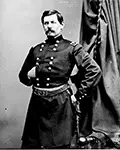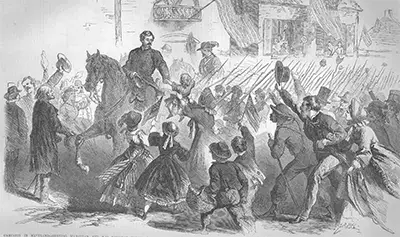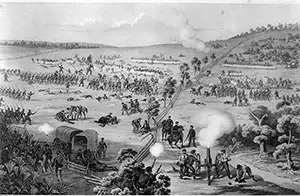Civil War General George McClellan
George McClellan was one of the most famous commanders of the American Civil War. A strong organizer, he became known for his caution in battle and his great reputation with his troops. 
He was born on Dec. 23, 1826, in Philadelphia. His father was a well-known eye doctor, and his grandfather Samuel had served as a general during the Revolutionary War, commanding troops at Lexington and Concord and at Bunker Hill. Young George went to private schools, a prep school, and the University of Pennsylvania for a time and then studied law before deciding on his ultimate career, in uniform. He gained appointment to the U.S. Military Academy at age 15, one year younger than most applicants, through the help of President John Tyler. McClellan proved an apt pupil and especially enjoyed studying military theory, particularly that of the famous French commander Napoleon Bonaparte. He graduated in 1846, second in his class, and stayed on at West Point, as part of the Corps of Engineers. (In his graduating class were 19 other men who served as generals in either the Union or the Confederate Army.) He soon shipped out for duty in the Mexican-American War and saw action only after recovering from a double bout with dysentery and malaria. He was on hand for Gen. Winfield Scott's advance on Mexico City and earned promotions for his actions at Contreras, Churubusco, and Chapultepec. After the war, McClellan returned to West Point to train more engineers. He wrote training manuals and, at the behest of then-Secretary of War Jefferson Davis, led a surveying expedition for the Transcontinental Railroad. Davis later assigned him to be an observer of the Crimean War, and he incorporated what he learned of European military tactics in a new training manual for the U.S. Army. He also designed a saddle that bore his name. In 1852, he accompanied Capt. Randolph Marcy to Arkansas to find the source of the Red River; Marcy named a small stream there after McClellan. He also was part of a team surveying rivers and harbors in Texas. McClellan enjoyed working on the railroad so much that he resigned from the army to take a job as chief engineer and vice president of the Illinois Central Railroad; that led to a relative promotion, to division president of the Ohio and Mississippi Railroad. However, when the Civil War began, he vowed to return to the military. Both North and South sought his services, and he agreed to lead a group of recruits from Ohio. Beginning his commission as major general of volunteers on April 23, 1861, he soon found federal employment again, this time as commander of the Department of the Ohio. A May 14 commission named him major general, putting him second in rank only to Scott, who had become the U.S. Army's top officer. McClellan had sent Scott a pair of detailed plans for winning the war when the former was still organizing Ohio volunteers, and Scott had dismissed both plans as unworkable. 
McClellan made a name for himself by winning a few small battles in Western Virginia–including the Battle of Philippi, the first land battle of the war–leading to his being called "the Young Napoleon." On that basis, he was called to Washington, D.C., after the Union Army's defeat at the First Battle of Bull Run. Scott and President Abraham Lincoln named him commander of the Military District of the Potomac, and he turned his strong organizational skills to creating a well trained and well cared for Army of the Potomac (by November 1861 numbering 168,000) and building extensive fortifications for the nation's capital. McClellan was so skilled at training his men and so adept at equipping them and showering them with praise that they espoused similar feelings for him. At the same time, he developed a strong attachment to the men he trained and equipped and did not want harm to come to them. This hesitancy cost him several times on the field of battle. McClellan and Scott clashed again when the former publicly made known his dislike of Scott's Anaconda Plan, a multi-pronged strategy for convincing the South by both military and economic means to offer surrender. McClellan also continued, as he had from his first command, to refuse to denounce or interfere with slavery as he encountered it. In later years, he voiced strong opposition to emancipation as well. Scott retired in October 1861, and Lincoln elevated McClellan to replace him. McClellan thought highly of himself and not so highly of others. This was evidenced in his frequent clashes with Scott, and McClellan did not remove Lincoln from this way of thinking. (In fact, McClellan refused to meet with Lincoln, his commander-in-chief, during one of the President's not infrequent battlefield visits.) McClellan became increasingly convinced that the Confederate forces were larger and more well trained than they actually were, and his response was increasingly one of demanding more men, money, and weapons. What he wasn't doing was fighting the enemy, which was what Lincoln wanted him to be doing. Lincoln at one point said to a gathering of his other generals, "If General McClellan does not want to use the army, I would like to borrow it for a time." The President summoned his general-in-chief to the White House on Jan. 12, 1862, and asked for a detailed battle plan. "Little Mac," as McClellan was also known, departed from his usual pattern of keeping secrets even from his commander-in-chief and unveiled a detailed plan for moving his army to Urbanna on the Rappahannock River and then marching on Richmond. Lincoln, along with many others, wanted Richmond taken, in the hope that such a symbolic victory would convince the South to surrender. While McClellan continued to make painstaking preparations for his new Peninsula Campaign, Southern troops moved to a new position along the Rappahannock. The ever cautious McClellan had to revise his plans yet again. The Army of the Potomac finally moved against the enemy but then allowed them to escape. McClellan had, among other experiences, had great exposure to the siege network employed at Sebastapol during the Crimean War. At Yorktown, the similar preparations that he directed took so long that the Confederate commander Johnston was able to bring in reinforcements. After the two armies clashed at Williamsburg, Johnston withdrew and McClellan did not follow, preferring to pause and regroup. In frustration, Lincoln removed McClellan as his top general, on March 11. McClellan was still in command of an army, though. The lumbering Union army, the largest American military force ever assembled, pursued their Confederate opponents further into Virginia. The two forces clashed on May 31 at Seven Pines. Casualties were high and the result inconclusive, and the Union army was only four miles from Richmond; McClellan, however, was convinced that defeat was just around the corner and waited three weeks for reinforcements. During that time, another force under Gen. Robert E. Lee attacked the Union troops. McClellan pulled back and fell into the Seven Days Battles, ending up at Harrison's Landing on the James River, supported by U.S. Navy gunships. With McClellan tied down, Lee moved north and guided the South to another victory at Bull Run/Manassas, on Aug. 28–30. Commanding the newly formed Army of Virginia at that battle was Major Gen. John Pope. Dismayed at Pope's defeat, Lincoln reluctantly reappointed McClellan to overall command of the army. McClellan responded by marching west to meet up with Pope's force and then target Lee's army, which had invaded Maryland. 
Chance intervened, as a Union soldier found a copy of Lee's troops movements. A Union victory at South Mountain presaged the next encounter, at Antietam Creek, near the town of Sharpsburg. There, on September 17, the Union and Confederate forces clashed in an epic battle that remains the one-day high for casualties on American soil. McClellan had far more troops than Lee did, but the former was still convinced of the latter's superior numbers and so held a substantial part of his force in reserve, while also attacking in fits and starts, allowing the defenders to survive what otherwise could have been a widespread defeat. As well, when Lee retreated from the field of battle, handing McClellan a technical victory, the Union general did not pursue Lee's badly beaten and exhausted troops, letting them escape to fight another day. Lincoln visited McClellan at Sharpsburg and, on November 5, removed him as head of the Army of the Potomac and ordered to him to his home in Trenton, N.J., there to await further orders. None came, despite further Union defeats, some spectacular. McClellan spent the next two years writing up reports of his time in command. McClellan entered the realm of politics in 1864, gaining the presidential nomination of the Democratic Party. He lost the election to Lincoln. He pursued another run at politics in 1877, winning election as Governor of New Jersey. He served one term and did not run for re-election. He had lived in Europe for a few years in between political stints. Also in his postwar years, he served as chief engineer of the New York City Department of Docks, that city's first Superintendent of Public Works, and the president of the Atlantic and Great Western Railroad. He had married Ellen Mary Marcy in 1860. They had two children, Mary and George, Jr. McClellan died on Oct. 29, 1885 at Orange, N.J. Named after him are many things, including a fort in Alabama. His memoir McClellan's Own Story came out after he died. |
|
Social Studies for Kids
copyright 2002–2024
David White




